Extending the Depth of Focus of an Infrared Microscope Using a Binary Axicon Fabricated on Barium Fluoride
Abstract
:1. Introduction
2. Methods
3. Simulation Studies
4. Optical Experiments with a Solid Axicon
5. Optical Experiments with a Spatial Light Modulator
6. Fabrication of Binary Axicon
7. Experiments with Synchrotron IR Beam
8. Experiments with IR Microscope
9. Conclusions and Future Perspectives
Author Contributions
Funding
Data Availability Statement
Conflicts of Interest
References
- Mertz, J. Introduction to Optical Microscopy, 2nd ed.; Cambridge University Press: Cambridge, UK, 2019. [Google Scholar]
- Park, S.; Kang, W.; Kwon, Y.D.; Shim, J.; Kim, S.; Kaang, B.K.; Hohng, S. Superresolution fluorescence microscopy for 3D reconstruction of thick samples. Mol. Brain 2018, 11, 17. [Google Scholar] [CrossRef]
- Tahara, T.; Quan, X.Y.; Otani, R.; Takaki, Y.; Matoba, O. Digital holography and its multidimensional imaging applications: A review. Microscopy 2018, 67, 55–67. [Google Scholar] [CrossRef]
- Rosen, J.; Brooker, G. Digital spatially incoherent Fresnel holography. Opt. Lett. 2007, 32, 912–914. [Google Scholar] [CrossRef]
- Brooker, G.; Siegel, N.; Wang, V.; Rosen, J. Optimal resolution in Fresnel incoherent correlation holographic fluorescence microscopy. Opt. Express 2011, 19, 5047–5062. [Google Scholar] [CrossRef]
- Rosen, J.; Brooker, G. Non-scanning motionless fluorescence three-dimensional holographic microscopy. Nat. Photon. 2008, 2, 190–195. [Google Scholar] [CrossRef]
- Rosen, J.; Alford, S.; Anand, V.; Art, J.; Bouchal, P.; Bouchal, Z.; Erdenebat, M.-U.; Huang, L.; Ishii, A.; Juodkazis, S.; et al. Roadmap on Recent Progress in FINCH Technology. J. Imaging 2021, 7, 197. [Google Scholar] [CrossRef]
- Praveen, P.A.; Arockiaraj, F.G.; Gopinath, S.; Smith, D.; Kahro, T.; Valdma, S.-M.; Bleahu, A.; Ng, S.H.; Reddy, A.N.K.; Katkus, T.; et al. Deep Deconvolution of Object Information Modulated by a Refractive Lens Using Lucy-Richardson-Rosen Algorithm. Photonics 2022, 9, 625. [Google Scholar] [CrossRef]
- Anand, V.; Han, M.; Maksimovic, J.; Ng, S.H.; Katkus, T.; Klein, A.; Bambery, K.; Tobin, M.J.; Vongsvivut, J.; Juodkazis, S.; et al. Single-shot mid-infrared incoherent holography using Lucy-Richardson-Rosen algorithm. Opto-Electron. Sci. 2022, 1, 210006. [Google Scholar]
- Ng, S.H.; Anand, V.; Han, M.; Smith, D.; Maksimovic, J.; Katkus, T.; Klein, A.; Bambery, K.; Tobin, M.J.; Vongsvivut, J.; et al. Computational Imaging at the Infrared Beamline of the Australian Synchrotron Using the Lucy–Richardson–Rosen Algorithm. Appl. Sci. 2023, 13, 12948. [Google Scholar] [CrossRef]
- Wang, Y.; Wang, H.; Liu, S.; Huang, T.; Zhang, W.; Di, J.; Rosen, J.; Lu, X.; Zhong, L. Unsupervised Deep Learning Enables 3D Imaging for Single-Shot Incoherent Holography. Laser Photonics Rev. 2024, 2301091. [Google Scholar] [CrossRef]
- Shimobaba, T.; Blinder, D.; Birnbaum, T.; Hoshi, I.; Shiomi, H.; Schelkens, P.; Ito, T. Deep-Learning Computational Holography: A Review (Invited). Front. Phys. 2022, 3, 854391. [Google Scholar] [CrossRef]
- Anand, V. Tuning Axial Resolution Independent of Lateral Resolution in a Computational Imaging System Using Bessel Speckles. Micromachines 2022, 13, 1347. [Google Scholar] [CrossRef]
- Kumar, R.; Vijayakumar, A.; Rosen, J. 3D single shot lensless incoherent optical imaging using coded phase aperture system with point response of scattered airy beams. Sci. Rep. 2023, 13, 2996. [Google Scholar] [CrossRef]
- Bleahu, A.; Gopinath, S.; Kahro, T.; Angamuthu, P.P.; Rajeswary, A.S.J.F.; Prabhakar, S.; Kumar, R.; Salla, G.R.; Singh, R.P.; Kukli, K.; et al. 3D Incoherent Imaging Using an Ensemble of Sparse Self-Rotating Beams. Opt. Express 2023, 31, 26120–26134. [Google Scholar] [CrossRef]
- Gopinath, S.; Rajeswary, A.S.J.F.; Anand, V. Sculpting axial characteristics of incoherent imagers by hybridization methods. Opt. Lasers Eng. 2024, 172, 107837. [Google Scholar] [CrossRef]
- Gopinath, S.; Anand, V. Post-Ensemble Generation with Airy Beams for Spatial and Spectral Switching in Incoherent Imaging. Opt. Open, 1119. [Google Scholar] [CrossRef]
- McLeod, J. The Axicon: A new type of optical element. J. Opt. Soc. Am. 1954, 44, 592–597. [Google Scholar] [CrossRef]
- Durnin, J. Exact solutions for nondiffracting beams. I. The scalar theory. J. Opt. Soc. Am. A 1987, 4, 651–654. [Google Scholar] [CrossRef]
- Durnin, J.; Miceli, J.J., Jr.; Eberly, J.H. Diffraction-free beams. Phys. Rev. Lett. 1987, 58, 1499. [Google Scholar] [CrossRef]
- Lapointe, M.R. Review on non-diffracting Bessel beam experiments. Opt. Laser Technol. 1992, 24, 315–321. [Google Scholar] [CrossRef]
- Khonina, S.N.; Kazanskiy, N.L.; Karpeev, S.V.; Butt, M.A. Bessel Beam: Significance and Applications—A Progressive Review. Micromachines 2020, 11, 997. [Google Scholar] [CrossRef]
- Khonina, S.N.; Karpeev, S.; Alferov, S.; Savelyev, D.; Laukkanen, J.; Turunen, J. Experimental demonstration of the generation of the longitudinal E-field components on the optical axis with high-numerical-aperture binary axicons illuminated by linearly and circularly polarized beams. J. Opt. 2013, 15, 085704. [Google Scholar] [CrossRef]
- Khonina, S.N.; Degtyarev, S. A longitudinally polarized beam generated by a binary axicon. J. Russ. Laser Res. 2015, 36, 151–161. [Google Scholar] [CrossRef]
- Khonina, S.N.; Kotlyar, V.; Soifer, V.; Jefimovs, K.; Paakkonen, P.; Turunen, J. Astigmatic Bessel laser beams. J. Mod. Opt. 2004, 51, 677–686. [Google Scholar] [CrossRef]
- Khonina, S.; Kotlyar, V.; Skidanov, R.; Soifer, V.; Jefimovs, K.; Simonen, J.; Turunen, J. Rotation of microparticles with Bessel beams generated by diffractive elements. J. Mod. Opt. 2004, 51, 2167–2184. [Google Scholar] [CrossRef]
- Khonina, S.N.; Kazanskiy, N.L.; Khorin, P.A.; Butt, M.A. Modern Types of Axicons: New Functions and Applications. Sensors 2021, 21, 6690. [Google Scholar] [CrossRef] [PubMed]
- Arimoto, R.; Saloma, C.; Tanaka, T.; Kawata, S. Imaging properties of axicon in a scanning optical system. Appl. Opt. 1992, 31, 6653–6657. [Google Scholar] [CrossRef] [PubMed]
- Bouchal, P.; Kapitan, J.; Konecny, M.; Zboncak, M.; Bouchai, Z. Non-diffracting light in nature: Anomalously reflected self-healing Bessel beams from jewel scarabs. APL Photonics 2019, 4, 126102. [Google Scholar] [CrossRef]
- Schafer, F.P. On some properties of axicons. Appl. Phys. B 1986, 39, 1–8. [Google Scholar] [CrossRef]
- Scott, G.; McArdle, N. Efficient generation of nearly diffraction-free beams using an axicon. Opt. Eng. 1992, 31, 2640–2643. [Google Scholar] [CrossRef]
- Vasara, A.; Turunen, J.; Friberg, A.T. Realization of general nondiffracting beams with computer-generated holograms. JOSA A 1989, 6, 1748–1754. [Google Scholar] [CrossRef]
- Dufour, P.; Piche, M.; Koninck, Y.D.; McCarthy, N. Two-photon excitation fluorescence microscopy with a high depth of field using an axicon. Appl. Opt. 2006, 45, 9246–9252. [Google Scholar] [CrossRef]
- Snoeyink, C.; Wereley, S. Single-image far-field subdiffraction limit imaging with axicon. Opt. Lett. 2013, 38, 625–627. [Google Scholar] [CrossRef]
- Schreiber, B.; Elsayad, K.; Heinze, K.G. Axicon-based Bessel beams for flat-field illumination in total internal reflection fluorescence microscopy. Opt. Lett. 2017, 42, 3880–3883. [Google Scholar] [CrossRef]
- Theriault, G.; Koninck, Y.D.; McCarthy, N. Extended depth of field microscopy for rapid volumetric two-photon imaging. Opt. Express 2013, 21, 10095–10104. [Google Scholar] [CrossRef]
- Sheppard, C.J.R.; Castello, M.; Tortarolo, G.; Deguchi, T.; Koho, S.V.; Vicidomini, G.; Diaspro, A. Image scanning microscopy with multiphoton excitation or Bessel beam illumination. J. Opt. Soc. Am. A 2020, 37, 1639–1649. [Google Scholar] [CrossRef]
- Perinchery, S.M.; Haridas, A.; Shinde, A.; Buchnev, O.; Murukeshan, V.M. Breaking diffraction limit of far-field imaging via structured illumination Bessel beam microscope (SIBM). Opt. Express 2019, 27, 6068–6082. [Google Scholar] [CrossRef]
- Soifer, V.A. (Ed.) . Computer Design of Diffractive Optics, 1st ed.; Woodhead Publishing: Cambridge, UK, 2012. [Google Scholar]
- O’Shea, D.C.; Suleski, T.J.; Kathman, A.D.; Prather, D.W. Diffractive Optics: Design, Fabrication, and Test; SPIE Press: Bellingham, WA, USA, 2004; Volume 62. [Google Scholar]
- Watt, F.; Bettiol, A.A.; Kan, J.A.V.; Teo, E.J.; Breese, M.B.H. Ion beam lithography and nanofabrication: A review. Int. J. Nanosci. 2005, 4, 269–286. [Google Scholar] [CrossRef]
- Chou, S.Y.; Krauss, P.R.; Renstrom, P.J. Nanoimprint lithography. J. Vac. Sci. Technol. B 1996, 14, 4129–4133. [Google Scholar] [CrossRef]
- Tseng, A.A.; Chen, K.; Chen, C.D.; Ma, K.J. Electron beam lithography in nanoscale fabrication: Recent development. IEEE Trans. Electron. Packag. 2003, 26, 141–149. [Google Scholar] [CrossRef]
- Han, M.; Smith, D.; Ng, S.H.; Katkus, T.; John Francis Rajeswary, A.S.; Praveen, P.A.; Bambery, K.R.; Tobin, M.J.; Vongsvivut, J.; Juodkazis, S.; et al. Single shot lensless interferenceless phase imaging of biochemical samples using synchrotron near infrared Beam. Biosensors 2022, 12, 1073. [Google Scholar] [CrossRef]
- Creagh, D.; McKinlay, J.; Dumas, P. The design of the infrared beamline at the Australian synchrotron. Vib. Spectrosc. 2006, 41, 213–220. [Google Scholar] [CrossRef]
- Anand, V.; Ng, S.H.; Katkus, T.; Maksimovic, J.; Klein, A.; Vongsvivut, J.; Bambery, K.; Tobin, M.J.; Juodkazis, S. Exploiting spatio-spectral aberrations for rapid synchrotron infrared imaging. J. Synchrotron. Rad. 2021, 28, 1616–1619. [Google Scholar] [CrossRef]
- Burvall, A.; Kołacz, K.; Jaroszewicz, Z.; Friberg, A.T. Simple lens axicon. Appl. Opt. 2004, 43, 4838–4844. [Google Scholar] [CrossRef]
- Belanger, P.; Rioux, M. Ring pattern of a lens-axicon doublet illuminated by a Gaussian beam. Appl. Opt. 1978, 17, 1080–1088. [Google Scholar] [CrossRef]
- Jaroszewicz, Z.; Morales, J. Lens axicons: Systems composed of a diverging aberrated lens and a perfect converging lens. JOSA 1998, 15, 2383–2390. [Google Scholar] [CrossRef]
- Rajesh, K.B.; Suresh, V.N.; Anbarasan, P.M.; Gokulakrishnan, K.; Mahadevan, G. Tight focusing of double ring shaped radially polarized beam with high NA lens axicon. Opt. Laser Technol. 2011, 43, 1037–1040. [Google Scholar] [CrossRef]
- Khonina, S.N.; Volotovsky, S.G.; Ustinov, A.V.; Porfirev, A.P. Spatiotemporal dynamics of the polarisation state of laser radiation performed by lens-axicon combinations. Phys. Lett. A 2019, 383, 2535–2541. [Google Scholar] [CrossRef]
- Takanezawa, S.; Saitou, T.; Imamura, T. Wide field light-sheet microscopy with lens-axicon controlled two-photon Bessel beam illumination. Nat. Commun. 2021, 12, 2979. [Google Scholar] [CrossRef]
- Bhuian, B.; Winfield, R.J.; O’Brien, S.; Crean, G.M. Pattern generation using axicon lens beam shaping in two-photon polymerization. Appl. Surf. Sci. 2007, 254, 841–844. [Google Scholar] [CrossRef]
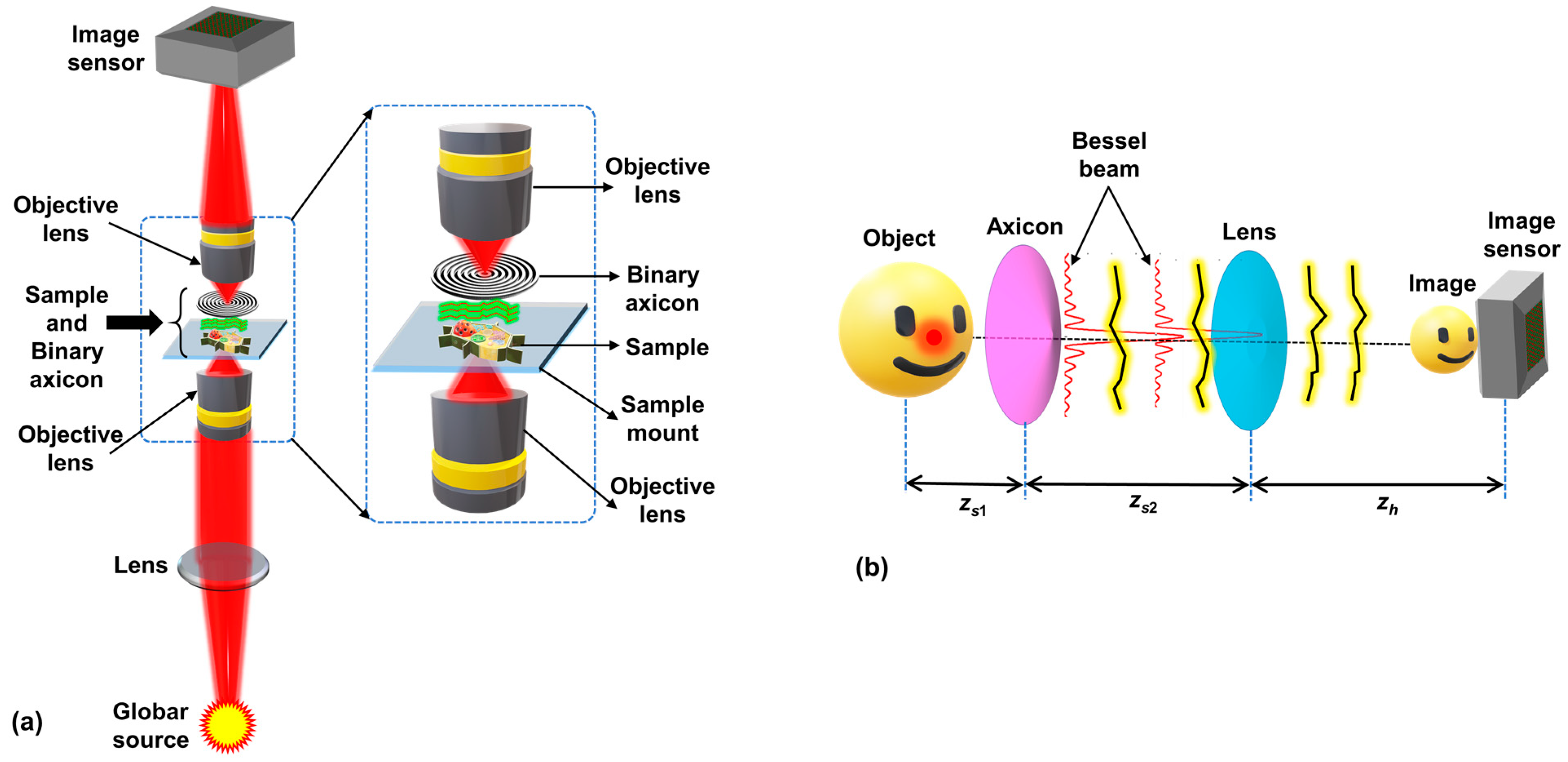

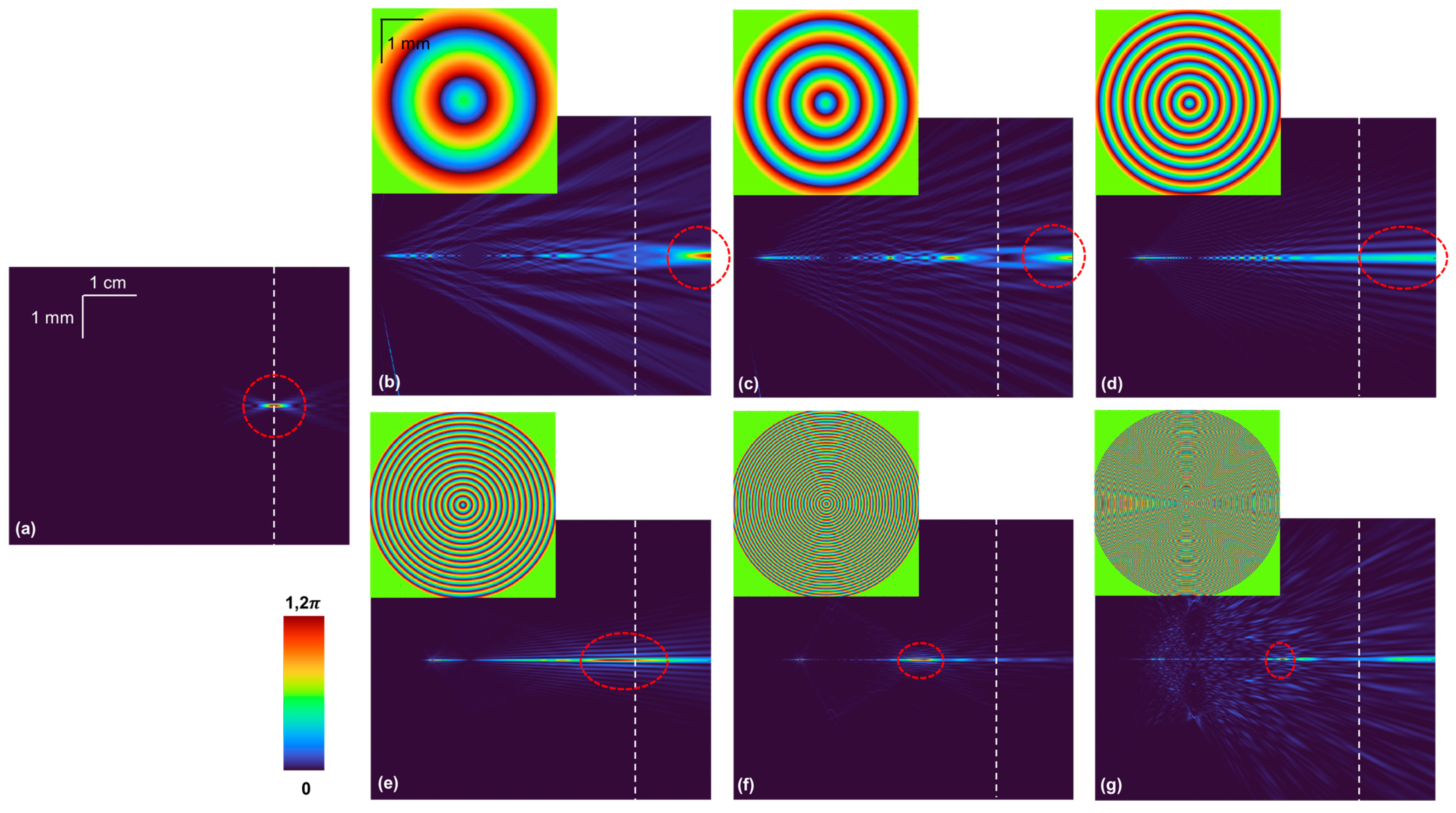
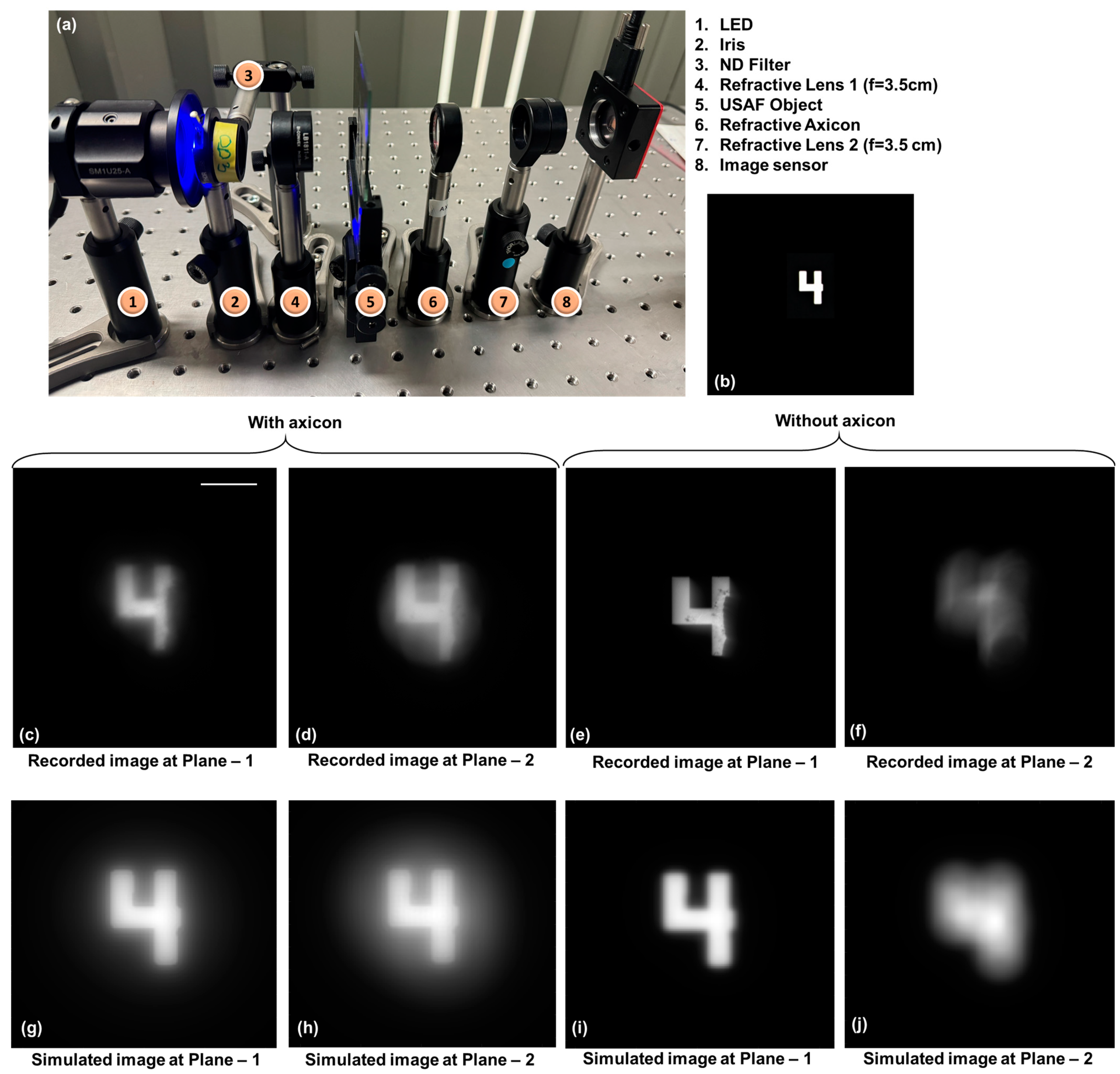
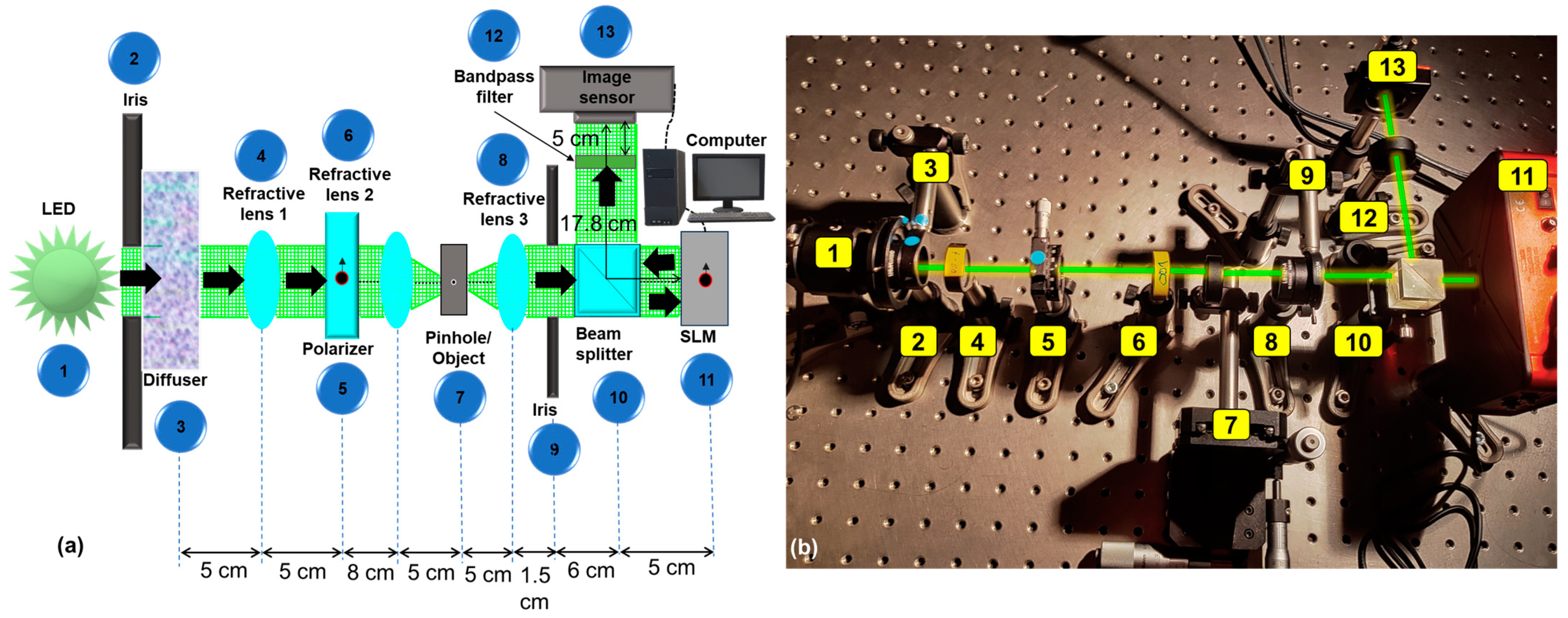

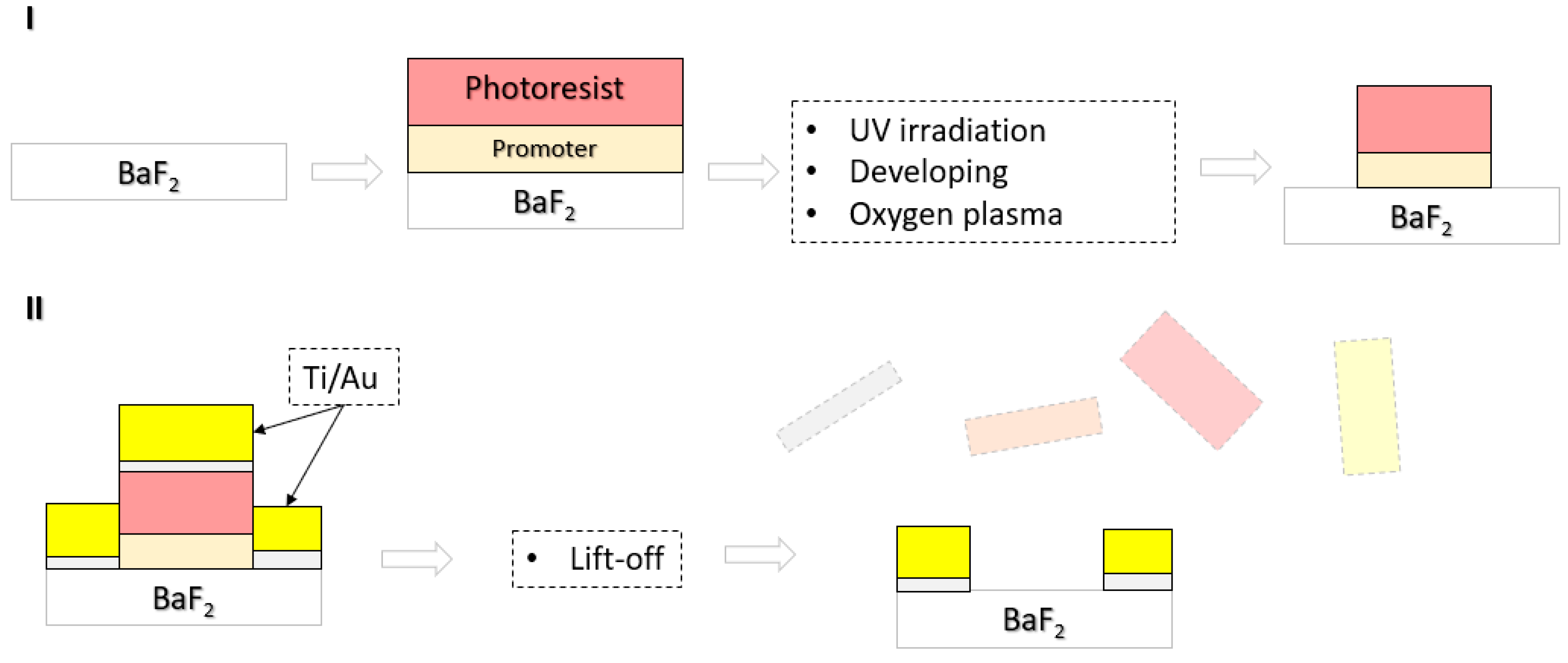
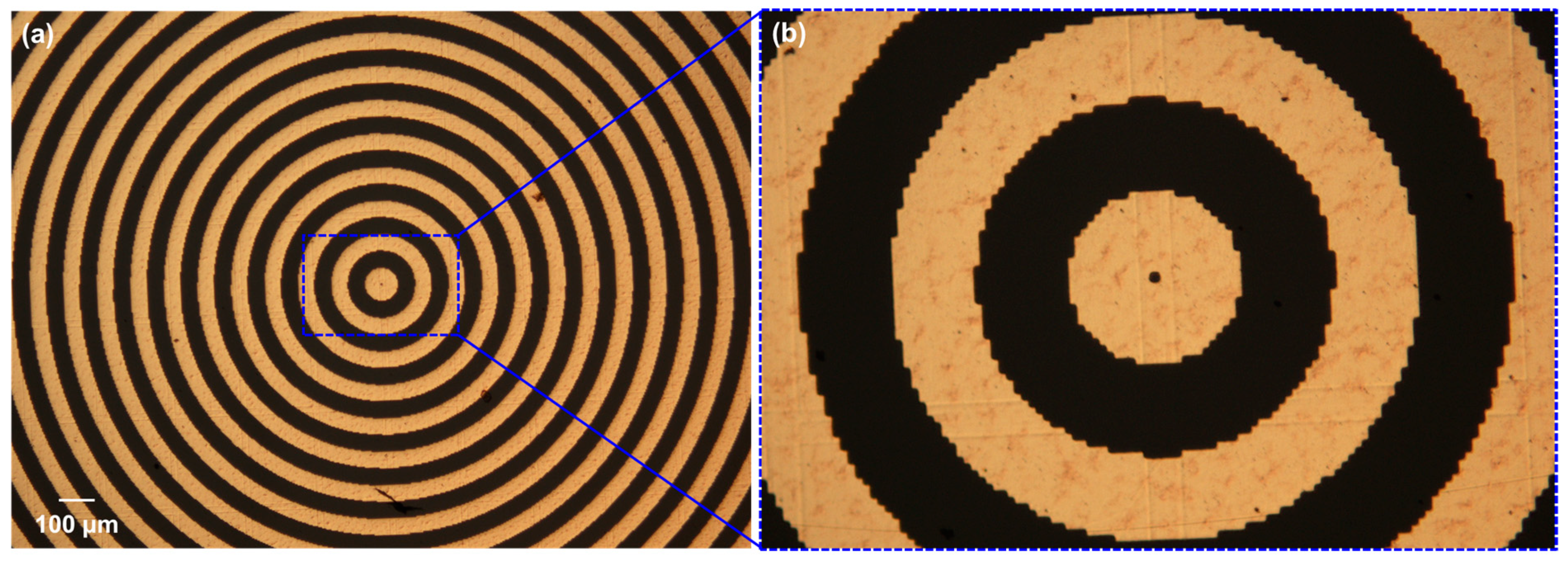
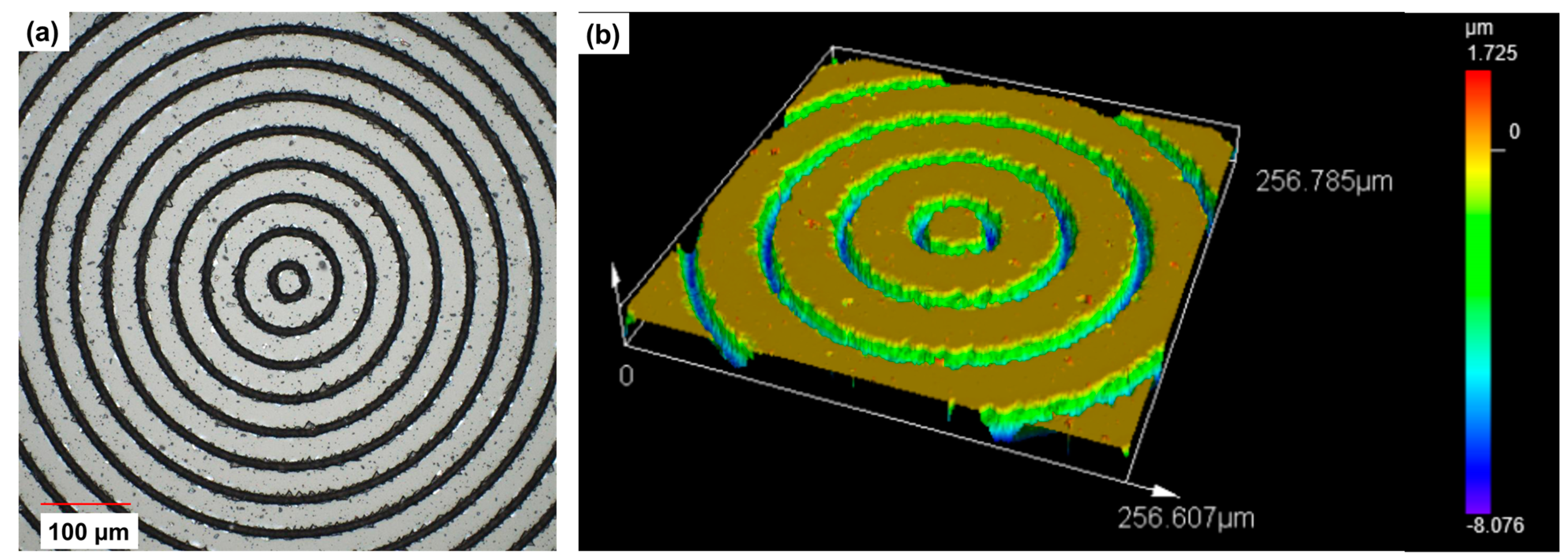
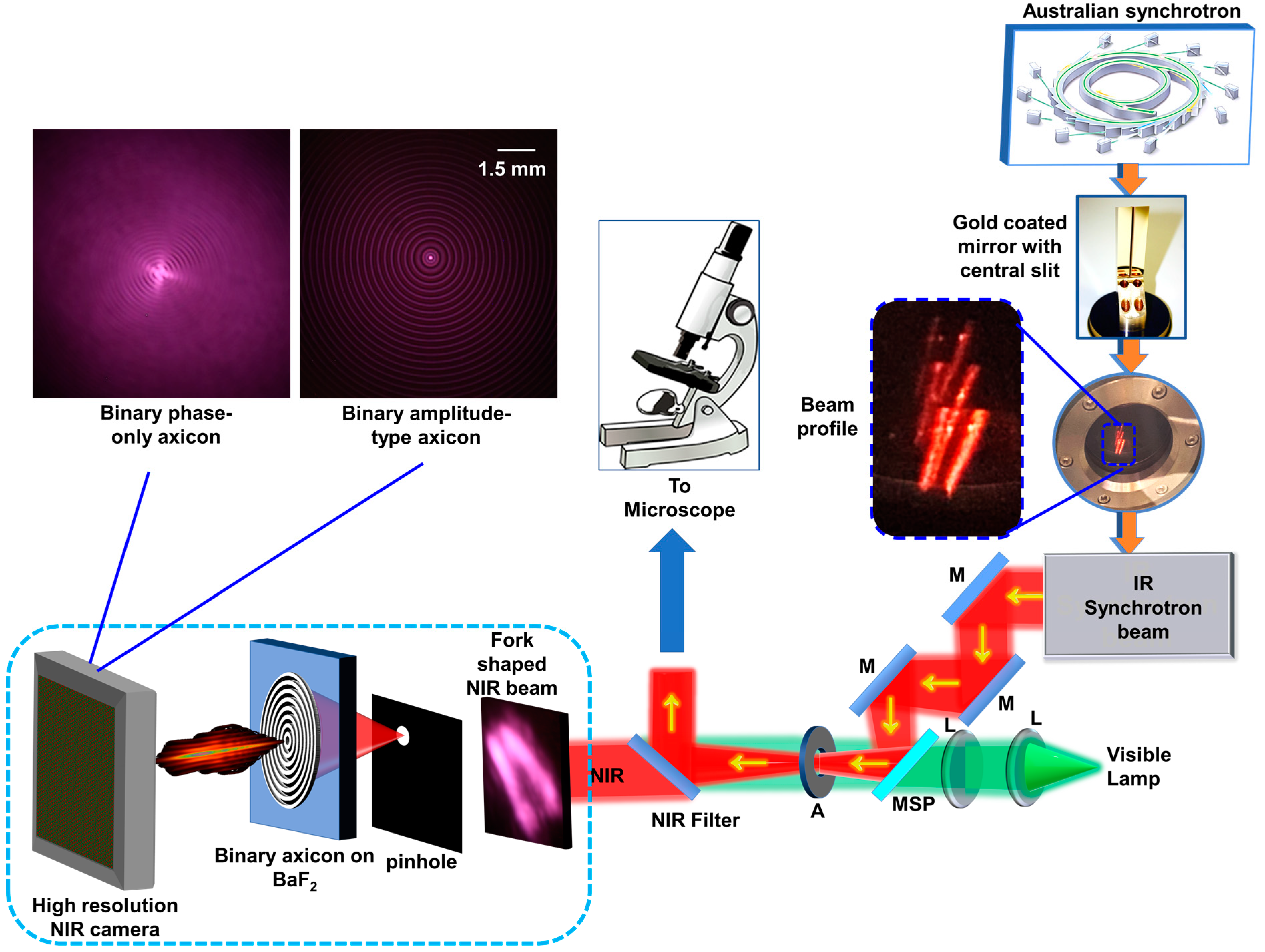
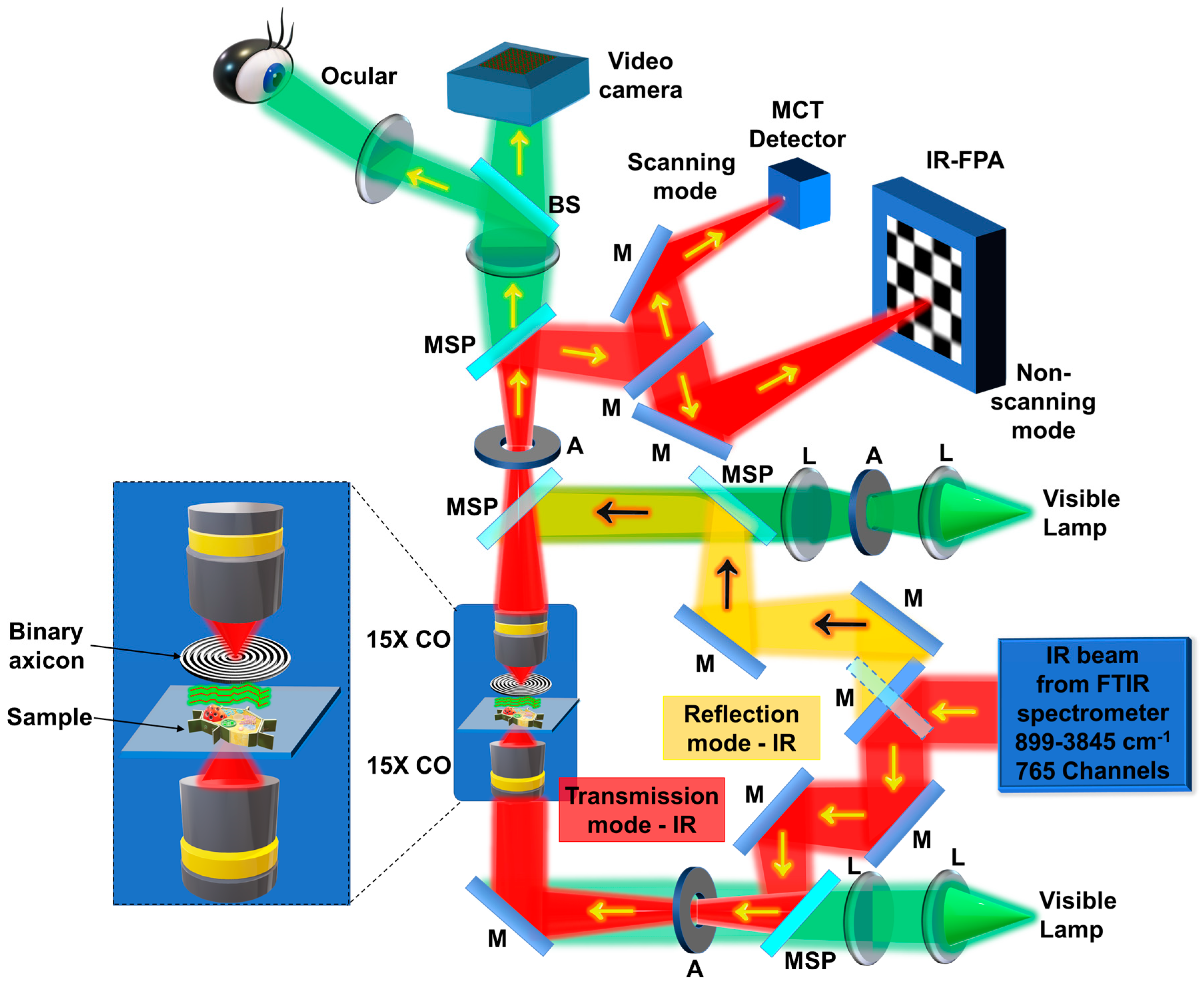
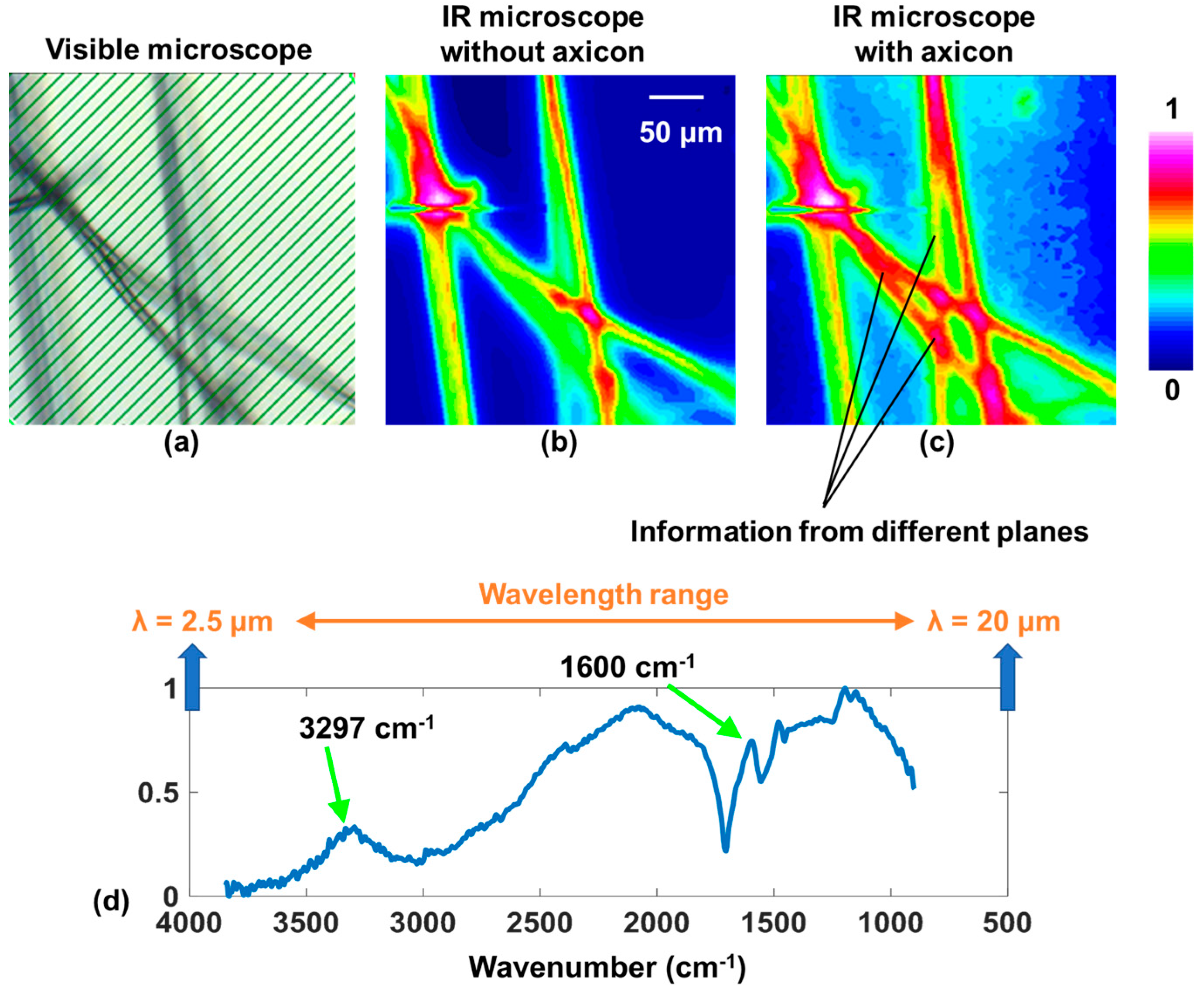
Disclaimer/Publisher’s Note: The statements, opinions and data contained in all publications are solely those of the individual author(s) and contributor(s) and not of MDPI and/or the editor(s). MDPI and/or the editor(s) disclaim responsibility for any injury to people or property resulting from any ideas, methods, instructions or products referred to in the content. |
© 2024 by the authors. Licensee MDPI, Basel, Switzerland. This article is an open access article distributed under the terms and conditions of the Creative Commons Attribution (CC BY) license (https://creativecommons.org/licenses/by/4.0/).
Share and Cite
Han, M.; Smith, D.; Kahro, T.; Stonytė, D.; Kasikov, A.; Gailevičius, D.; Tiwari, V.; Ignatius Xavier, A.P.; Gopinath, S.; Ng, S.H.; et al. Extending the Depth of Focus of an Infrared Microscope Using a Binary Axicon Fabricated on Barium Fluoride. Micromachines 2024, 15, 537. https://doi.org/10.3390/mi15040537
Han M, Smith D, Kahro T, Stonytė D, Kasikov A, Gailevičius D, Tiwari V, Ignatius Xavier AP, Gopinath S, Ng SH, et al. Extending the Depth of Focus of an Infrared Microscope Using a Binary Axicon Fabricated on Barium Fluoride. Micromachines. 2024; 15(4):537. https://doi.org/10.3390/mi15040537
Chicago/Turabian StyleHan, Molong, Daniel Smith, Tauno Kahro, Dominyka Stonytė, Aarne Kasikov, Darius Gailevičius, Vipin Tiwari, Agnes Pristy Ignatius Xavier, Shivasubramanian Gopinath, Soon Hock Ng, and et al. 2024. "Extending the Depth of Focus of an Infrared Microscope Using a Binary Axicon Fabricated on Barium Fluoride" Micromachines 15, no. 4: 537. https://doi.org/10.3390/mi15040537
APA StyleHan, M., Smith, D., Kahro, T., Stonytė, D., Kasikov, A., Gailevičius, D., Tiwari, V., Ignatius Xavier, A. P., Gopinath, S., Ng, S. H., John Francis Rajeswary, A. S., Tamm, A., Kukli, K., Bambery, K., Vongsvivut, J., Juodkazis, S., & Anand, V. (2024). Extending the Depth of Focus of an Infrared Microscope Using a Binary Axicon Fabricated on Barium Fluoride. Micromachines, 15(4), 537. https://doi.org/10.3390/mi15040537









